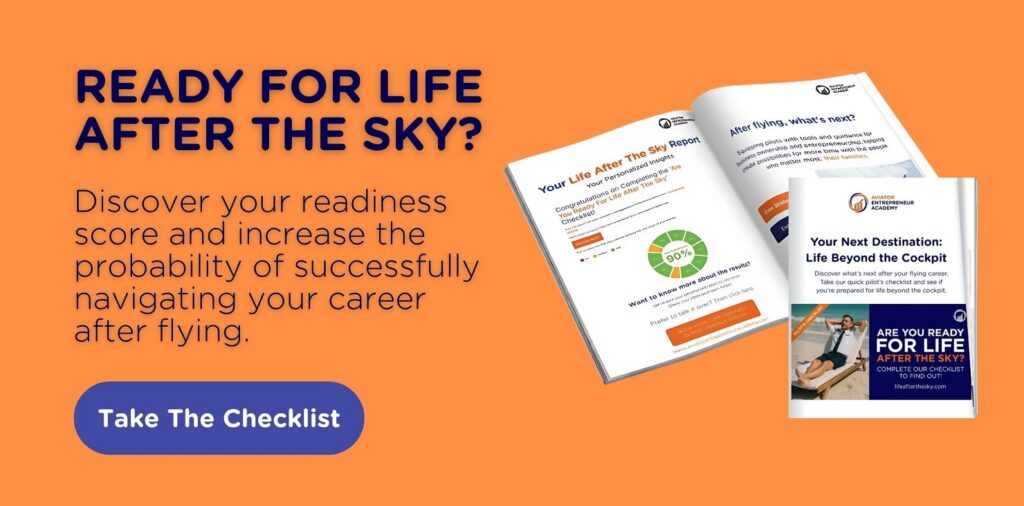There’s a dream we return to often. We revisit it between layovers, in quiet hotel rooms, or on long-haul red-eye flights. It waits patiently at the edge of our thoughts, promising clarity once things settle.
What many pilots don’t realize is that the longer we wait, the harder it becomes to reconnect with that dream.
We tell yourself the dream is still alive because it’s still “on the list,” only to watch it quietly drift away.
In life, just like the air, direction matters more than duration. Let’s see how.
Key Takeaways
- Long-term goals can mask inaction: A 10-year dream gives the illusion of planning while silently postponing real progress.
- Delays create new defaults: Studies show that 92% of people never achieve their long-term goals. That’s a wake-up call to stop relying on distant plans.
- Small steps now beat big plans later: You don’t need to launch the full version of your dream. Start with a test, a prototype, a weekend version. Action reveals more clarity than thinking ever can.
- Take the AEA scorecard: It’s a quick way to assess if your Ambition, Execution, and Alignment are on the same runway or if you’ve been taxiing in circles.

Why Do Delays Feel Safer Than Actions? The 10-Year Mirage
As a pilot, we live by precision.
ETAs. Altitudes. Airspeeds.
But when it comes to personal goals, it’s easy to drift into a long timeline.
If you’re thinking, “I’ll start my business after I upgrade,” then you’re not the only one.
High-performing individuals, especially in aviation, tend to project bold dreams far into the future because it feels like a controlled and safe environment.
But here’s the trap: long-term plans are often mental placeholders, a sophisticated way to delay action while still feeling productive. We’re not saying “no” to the dream, but we’re not even saying “yes” either.
You may be surprised to learn that a report by Psychology Today revealed that 92% of people never achieve their long-term goals.
So, do we want to be in this 92% or do we want to stand out and be in the other 8%?
Our choice.
As pilots, we’d never accept a 10-year nav route with no updates. So why accept it in our careers or personal lives?
The Trade-Off No One Talks About
Every year we delay, it’s not just time passing, it’s time being replaced.
New routines form around smaller goals. Comfort becomes the default. Eventually, we start questioning whether the life we once imagined even fits anymore.
As a pilot, this shift often feels subtle. We’re moving, flying, and checking off all the boxes. On the surface, everything appears steady. Look a little closer, and the repetition becomes clear: the same workouts in the same layover hotels, short-term financial targets, the two-week rotation over and over again.
I once spoke with an A330 captain who had long envisioned retiring into a slower, more grounded life. His dream was to build an eco-lodge in the Kenyan highlands. He could describe the land, the design, the kind of travelers he wanted to host, but it remains on paper.
The vision, however, was always “ten years from now.”
Is it really a plan if it never moves closer?
When we revisited the idea with a shorter timeline in mind, things shifted. He didn’t need to own land or wait for approvals. By partnering with existing eco-lodges, he could begin hosting weekend retreats, slowly building his presence and learning along the way.
This is what often goes unnoticed.
The longer something is postponed, the more distant it feels, not just in time, but in belief. Eventually, we stop preparing for it altogether.
Time Doesn’t Just Pass, It Shapes the Path
In aviation, time isn’t neutral. Every passing minute impacts fuel burn, available alternates, and the decisions we make.
It frames our flight plan, and life works the same way.
When we stretch our goal over 10 years, we unconsciously start designing a path that needs to last those 10 years. We begin to think in checkpoints: “First I’ll do X, then maybe Y… and if that works, I’ll finally be ready for Z.”
Yet many of those checkpoints may not need to exist at all.
Dr. Benjamin Hardy and Dan Sullivan, authors of 10x Is Easier Than 2x, explain this clearly: most people spend time “optimizing things that shouldn’t exist.”
We build long routes around imagined obstacles, not because the path requires it, but because we assume we’re not ready to go directly. Pilots witness this regularly. A direct route might shave twenty minutes off a flight, but it’s often bypassed in favor of legacy airways and familiar procedures.
In life, the same thing happens. Unless we challenge it, we’ll default to a plan that feels safe, even if it slows us down. Ask yourself: What steps in my current timeline exist only because I created a 10-year route?
Flight Plan vs. Dream Map
As a pilot, we would never enter controlled airspace without a flight plan on file. We’d never launch without knowing fuel, alternates, and ETA. Additionally, we’d never tell ATC, “We’re just headed in that general direction… we hope to land somewhere interesting.”
However, outside the cockpit, that’s exactly what many of us do.
We dream, we journal, and we sketch loose maps in the back of a planner and call it vision. But maps aren’t flight plans. It doesn’t define the timeline, the route, or the resources required to reach the destination.
Think of the ex-aviation maintenance officer who wanted to launch a full aviation training school “in the next decade.” He was deeply engaged in research, developing a 300-page curriculum, and consulting with CAA experts.
On paper, it looked like progress.
But when asked to execute the plan, the truth surfaced. He didn’t need to start a full school. He could launch a short bootcamp in composite repair, one he could scale later.
If we were in his shoes, would we have taken the leap of faith with the small step first, or just kept waiting for the bigger plan to unfold?
Shift to Action: Make the Future Urgent
When we move a 10-year dream into a 3-year window, something powerful happens: we start asking better questions.
We don’t wonder “what if,” we start asking, “what’s first?”
That compression creates urgency, which reveals the truth. It forces us to confront realities that we could otherwise ignore for a decade.
Here, we need to understand Daniel Kahneman’s research on time perception.
It shows that people routinely underestimate how much their environment and identity can shift in a short span, especially when urgency is applied.
What feels like a 5-year transformation often happens in 18 months, if the plan is real.
Let’s take another example of the pilot-turned YouTuber who wanted to build a 7-figure creator brand in “five to seven years.” His actions didn’t match his ambitions, editing solo, avoiding monetization, and uploading inconsistently.
But when he compressed the timeline to 18 months, his posture changed. He built systems, tested offers, and hired help. Suddenly, he wasn’t playing for views; he was building a business.
Ready for Takeoff, or Just Taxiing in Circles?
Dreams require more than imagination. A plan without pressure will always feel safe, and safety often disguises itself as progress.
Clarity is where progress begins. Instead of waiting for the perfect moment, choose to define the next step.
If that dream still matters, let’s treat it like something that deserves execution, not just admiration.
Got three minutes for yourself?
Take the AEA Scorecard now and see if your ambition is still aligned with your actions.
Invitation to join our FREE Strategy Session
Most pilots are one honest conversation away from clarity. This is that conversation.
Complete our “Life After the Sky” checklist, then join me for a FREE 15-minute “Strategy Session” via Zoom.
This session has been created for pilots who want to take ownership of what comes next.
Those who want action, not just to talk about it.
In just 15 minutes, we’ll:
- Review your checklist results
- Identify the one obstacle holding back your reinvention
- Translate your checklist results into a clear starting point
Start your pre-flight assessment for the next chapter of your journey by Booking your free strategy session here!



